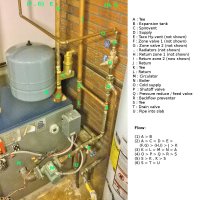Tangent
New Member
There are two issues I observe in my boiler heating system: (a) excessive pressure variation and (b) air trapped in the system.
The distance from the lowest to highest point in the system is 8 feet, thus the minimum required pressure would be (8 / 2.31 + 3) ~= 6.5 psi. The operating pressure varies from 12 psi (water T = 110 F) to 21 psi (water T = 180 F). The expansion tank is new, and tapping the tank with a stick in various spots sounds like it is half full. The pre-charge, before installation, was measured at 12.5 psi. The tank size is 4.4 gal, the same as the previous one, and the size recommended by the sizing calculator on the Amtrol web site. There are no vents near the radiators. There are no leaks from the T/P release valve or at the boiler drain valve, or anywhere else as far as I can see.
I discovered the prior expansion tank was water-logged, and thought the new tank would fix the excessive pressure variation. I spoke with tech support at Spirovent, who informed me that my installation has the expansion tank in the wrong location – it should be located on the suction side of the circulator. I also noticed that the the backflow preventer appears to be in the wrong location: in Watts documentation it is before the pressure reducing / feed valve.
The system has been flushed this year, and in the past by professionals. It will run fine for a couple of weeks, then air will start creeping in. The Taco Hy-vent was replaced last year during the flush, and this year a Spirovent was added. This year, the air came back after 3-4 days. Tech support at Spirovent suggested I close off the Taco hy-vent, since it was possible a negative pressure condition existed and air was entering via that device. That seemed to help somewhat.
A photo of the system is attached. It's not pretty – a number of different contractors have repaired the system over the years.
My questions are:
(1) Should the feed valve and tank pre-charge be lowered to 10 psi, since 12 is much more than required?
(2) Should the expansion tank be moved to a location before the circulator?
(3) Should the order of the backflow preventer and feed valves be changed?
(4) Should a new feed valve be installed? It seems OK in manual mode.
(5) Why are there pipes from the backflow preventer into the concrete slab? That section runs hot, and I don't know where it leads.
Thanks in advance for your comments.
The distance from the lowest to highest point in the system is 8 feet, thus the minimum required pressure would be (8 / 2.31 + 3) ~= 6.5 psi. The operating pressure varies from 12 psi (water T = 110 F) to 21 psi (water T = 180 F). The expansion tank is new, and tapping the tank with a stick in various spots sounds like it is half full. The pre-charge, before installation, was measured at 12.5 psi. The tank size is 4.4 gal, the same as the previous one, and the size recommended by the sizing calculator on the Amtrol web site. There are no vents near the radiators. There are no leaks from the T/P release valve or at the boiler drain valve, or anywhere else as far as I can see.
I discovered the prior expansion tank was water-logged, and thought the new tank would fix the excessive pressure variation. I spoke with tech support at Spirovent, who informed me that my installation has the expansion tank in the wrong location – it should be located on the suction side of the circulator. I also noticed that the the backflow preventer appears to be in the wrong location: in Watts documentation it is before the pressure reducing / feed valve.
The system has been flushed this year, and in the past by professionals. It will run fine for a couple of weeks, then air will start creeping in. The Taco Hy-vent was replaced last year during the flush, and this year a Spirovent was added. This year, the air came back after 3-4 days. Tech support at Spirovent suggested I close off the Taco hy-vent, since it was possible a negative pressure condition existed and air was entering via that device. That seemed to help somewhat.
A photo of the system is attached. It's not pretty – a number of different contractors have repaired the system over the years.
My questions are:
(1) Should the feed valve and tank pre-charge be lowered to 10 psi, since 12 is much more than required?
(2) Should the expansion tank be moved to a location before the circulator?
(3) Should the order of the backflow preventer and feed valves be changed?
(4) Should a new feed valve be installed? It seems OK in manual mode.
(5) Why are there pipes from the backflow preventer into the concrete slab? That section runs hot, and I don't know where it leads.
Thanks in advance for your comments.


